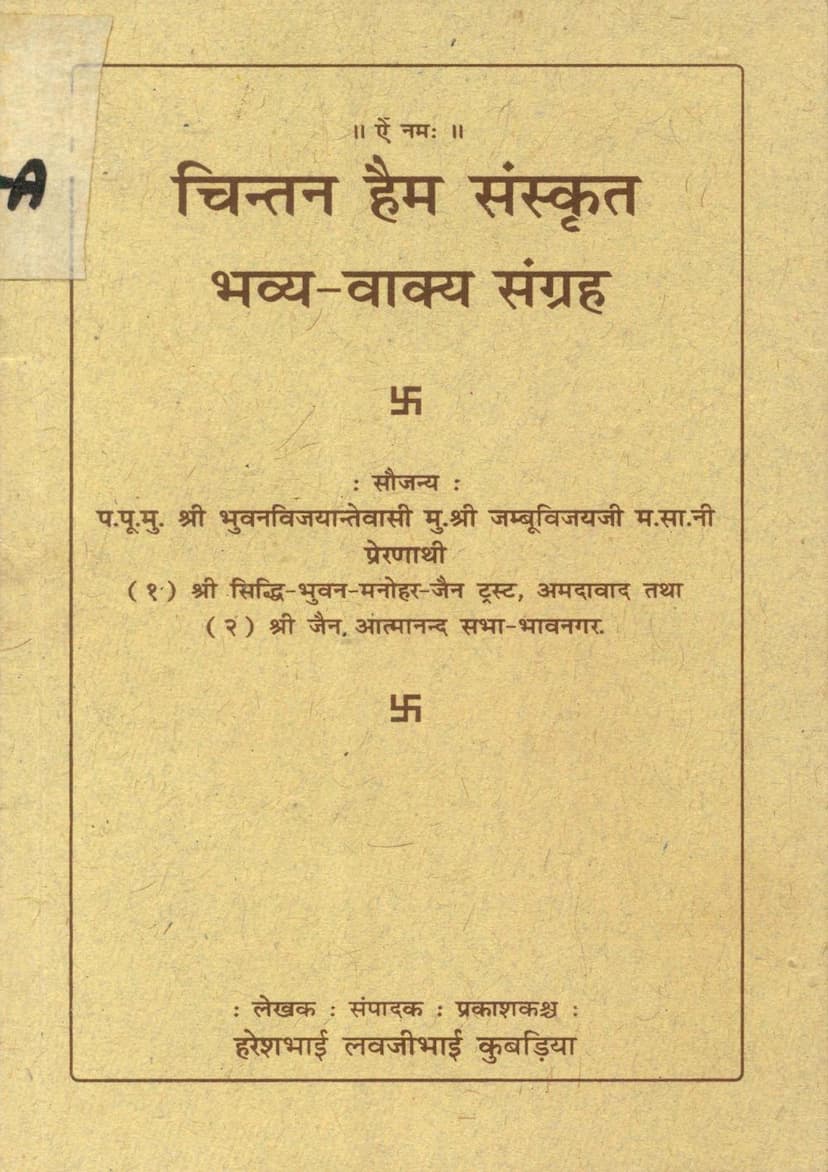Chintan Haim Sanskrit Bhavya Vakya Sangraha
Added to library: September 1, 2025

Summary
This document is a collection of Sanskrit and Gujarati sentences intended for learning and practicing grammar and vocabulary. The book title is "Chintan Haim Sanskrit Bhavya Vakya Sangraha" (चिन्तन हैम संस्कृत भव्य-वाक्य संग्रह), authored and published by Haresh L Kubadiya.
Here's a breakdown of the content based on the provided pages:
Introduction and Publisher Information:
- Title: Chintan Haim Sanskrit Bhavya Vakya Sangraha (A collection of auspicious sentences in Sanskrit for contemplation).
- Author/Editor/Publisher: Haresh L Kubadiya.
- Inspiration/Patronage: The book is presented with the blessings and inspiration of Param Pujya Muni Shri Jambuvijayji M. Sa. and supported by Shri Siddhi-Bhuvan-Manohar-Jain Trust, Ahmedabad, and Shri Jain Atmanand Sabha, Bhavnagar.
- Publication Details:
- First Edition.
- Year: Samvat 2061 Veer Samvat 2531, E. Samvat 2005.
- Price: Mentioned as "Moolya Pāṭhan Pāṭhan" (Value for reading and study), with a copy count of 1000.
- Contact Information: Haresh L Kubadiya's address and mobile number are provided for obtaining the book.
- Copyright: All rights are reserved. The book is intended for educational purposes for lay followers (Shravaks) to study.
- Contributors: Several individuals and organizations are listed as contributors to the writing and support of the book, including P. Pu. Sa. Shri Tattvagunashriji M. Sa., Shreshthivarya Shri Hasmukhbhai Shamjibhai Dhami, Subhashnagar Jain Sangh Ujjain, and Pankajkumar Motichand Zaveri.
- Spiritual Guidance: The book receives divine grace and blessings from various esteemed Jain monks, including Ganaadheesh Shri Jin Sukh Sagarji M. Sa., Aagamjyoti P. Pra. Shri SajjanSHRIji M. Sa., Ganaadheesh Pravar P. Pu. Shri Kailash Sagarji M. Sa., and Upadhyay Pravar Marudharmani P. Pu. Shri Maniprabh Sagarji M. Sa.
- Financial Support: Shri Vadodara Jain Khartargachchhiya Sangh is acknowledged for a contribution of Rs. 5000/-.
Content Outline (based on the Index and page content):
The book is structured around grammatical concepts and vocabulary, presenting sentences in both Gujarati and Sanskrit. The primary focus appears to be on verb conjugations, sentence structures, and the use of various grammatical cases and forms.
The index (अनुक्रमणिका) indicates coverage of:
- Pronouns: Ahham (I), Avaam (We), Vayam (We), Tvam (You), Yuvam (You two), Yuyam (You all), Sah (He), Tau (They two), Te (They all).
- Grammatical Cases (Vibhakti): Karta (Nominative), Karma (Accusative), Karan (Instrumental), Sampradan (Dative), Apadan (Ablative), Sambandh (Genitive), Adhikaran (Locative), Sambodhan (Vocative).
- Verbs and Tenses:
- Current Tense (Vartaman) in active (Kartari) and passive (Bhave) voice for all persons (Pratham, Dwitiya, Trutiy Purush).
- Other verb moods and forms are likely included throughout.
- Other Grammatical Concepts:
- Alamb (Alamb): Likely related to sufficiency or being without something.
- Hetunam (Purpose/Cause): Purpose and instrumental cause.
- Sampradan (Dative): For (माटे).
- Ruchi (Like/Fondness): (रुचि).
- Spriha (Desire/Longing): (स्पृहा).
- Vina (Without): (विना).
- Sambandh (Relationship/Possession): Likely covered implicitly or explicitly.
- Apādan (Ablative): From.
- Sambodhan (Vocative): Addressing.
- Visheshan-Visheshya (Adjective-Noun): Descriptions.
- Kridant (Verbal Participles): Present participle.
- Alamb: Likely a grammatical term.
- Dhig (Shame/Woe): (धिग्).
- Bahuvrihi: A type of compound word.
- Nanj Tatpurush: A compound using the negative prefix 'na'.
- Dvanda: A compound of multiple words.
- Gauna Naam (Secondary Nouns): Possibly related to appositives or secondary descriptions.
- Gujarati + Sanskrit: Sentences in both languages.
- Patram/Patrakam/Dalam: Leaf/Letter.
Sample Content Snippets:
The pages show extensive lists of sentences designed to illustrate grammatical points. For example:
- Page 6: Sentences for "Ahham" (I) with various verbs like "I read," "I worship," "I eat," "I go," etc.
- Page 7-8: Sentences for "Avaam" (We) with verbs like "We bow," "We live," "We enter," "We plant," etc.
- Page 9-10: Sentences for "Vayam" (We) and "Tvam" (You) with similar verb conjugations.
- Page 11-17: Continues with pronouns and various verb forms, covering different tenses and voices.
- Page 17-25: Introduces various cases and their uses with examples, such as "Kartā" (Subject), "Karma" (Object), "Karaṇ" (Instrumental), "Hetu" (Cause), "Sah" (With), "Sampradān" (Dative - 'for'), "Ruchi" (Like), "Sprihā" (Desire), "Apādān" (From), "Adhikaraṇ" (Locative - 'in/on'), and "Sambodhan" (Vocative).
- Page 25-32: Focuses heavily on "Visheshan-Visheshya" (Adjective-Noun) pairings, creating descriptive phrases.
- Page 33-38: Explains "Vartaman Kartari + Bhāve" (Present tense, active + passive voice) for first, second, and third persons.
- Page 38-43: Covers "Apādan" (From), "Vina" (Without), and "Sampraśna" (Questions).
- Page 43-46: Deals with "Sampraśna" (Questions) and "Vartaman Nakaratmak" (Present tense negative), "Viddhyarth Nakaratmak" (Negative imperative), "Agyarth Nakaratmak" (Negative command).
- Page 46-51: Continues with "Tum" (You) and related grammatical structures.
- Page 51-63: Explores "Hetunam" (Cause/Reason), "Sah" (With), "Sambhav" (Possibility), "Sati Saptami" (A specific grammatical construction likely involving the seventh case), "Anadar Shashthi" (Disrespectful Genitive), and "Visheshan-Visheshya" again.
- Page 63-68: Continues with "Anadar Shashthi" and "Sati Saptami."
- Page 68-75: Features extensive examples of "Visheshan-Visheshya-Kridant" (Adjective-Noun-Participle) structures.
- Page 75-87: Demonstrates various grammatical forms like "Alamb" (Sufficiency/Not enough), "Hetunam" (Purpose/Cause), "Sah" (With), "Sambhav" (Possibility), "Sati Saptami," "Anadar Shashthi," "Vruddhi" (likely refers to a case or grammatical concept), "Dhigg" (Shame), "Bahuvrihi" (Compound word), "Nanj Tatpurush" (Negative compound), "Dvanda" (Co-relative compound).
- Page 87-95: Further delves into "Dhigg" (Shame/Woe) and "Bahuvrihi" compounds.
- Page 95-102: Focuses on "Nanj Tatpurush" (Negative compounds) and continues with "Bahuvrihi" compounds.
- Page 102-108: Explores "Dvandva" (Co-relative compounds) and "Gauna Naam Shashthi" (Secondary Genitive/Appositive Genitive).
- Page 108-113: Includes a section on "Gujarati + Sanskrit" sentences, providing translations or parallel usage.
- Page 113-122: Continues with the Gujarati + Sanskrit section, covering a wide range of vocabulary and sentence structures, often illustrating similar concepts in both languages.
In essence, this book is a comprehensive workbook for learning Sanskrit grammar and vocabulary through the lens of Jain philosophy and practice, using Gujarati as the base language for translation and context. It aims to build proficiency in sentence construction and understanding grammatical nuances.